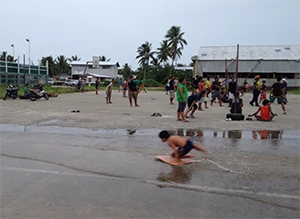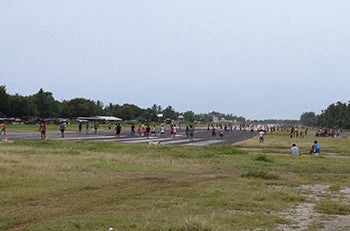Touchdown on th
 e runway at Funafuti Airport in Tuvalu. The ATR-42 that brought us here from Nadi in Fiji slowly rolls toward the apron and as we step off the plane we are greeted by what seems to be a Welcome Committee for the plane’s arrival. With only two flights a week, the excitement of airplanes landing and departing has clearly not worn off yet – from grandmothers to playing children, young men on
e runway at Funafuti Airport in Tuvalu. The ATR-42 that brought us here from Nadi in Fiji slowly rolls toward the apron and as we step off the plane we are greeted by what seems to be a Welcome Committee for the plane’s arrival. With only two flights a week, the excitement of airplanes landing and departing has clearly not worn off yet – from grandmothers to playing children, young men on
scooters and teenagers, they have all assembled around the airport and its adjacent pavilion for what appears to be something of a ritual. I have loved spending time at airports since I was a toddler, so I can’t help but smile. It seemed my first operational mission had brought me to the right place.
The project that we have come to Tuvalu for is part of the Pacific Aviation Investment Program (PAIP). In December 2012, the World Bank approved US$125 million in grants under PAIP to improve aviation safety and security in Tuvalu, Kiribati, and Tonga in a first phase, and Samoa as well as potentially Vanuatu in subsequent phases. Due to their remoteness, safe, efficient and affordable air transport is crucial in these countries.
Funafuti airport is our first stop. This small airport with its 1,524-meter-long and 30-meter-wide runway plays an important role in the capital’s community. On this 26-km 2 island, remotely located in the South Pacific and home to 10,000 people, land is scarce and space for any communal activity limited. ‘Multi-purpose’ is therefore a key concept here. As the Fiji Airways plane takes off and disappears in the bright blue Pacific sky, people flock slowly onto the runway armed with goal posts, volley balls and wet clothes that need drying. Suddenly the runway is full of life – people playing games, sitting on the ground deep in conversation or just strolling towards the oceanfront at the end of the runway. It is a rare picture for someone whose image of an airport is more like Heathrow in London or Dulles in Washington: a large fenced-off area with sizeable modern terminal buildings and endless rows of aircraft, where the only community involvement occurs when complaints arise about aircraft noise.

Sitting in the air traffic control tower with the senior flight service officer and his two female deputies, they explain to me the procedures that have been put in place to try to mitigate this risk: a first horn blow as a preliminary warning, a second horn blow, a red flag and a car patrolling the area while announcing the arrival of the aircraft, and finally, a last horn blow shortly before the aircraft lands. Although this may seem a rather rudimentary approach, it allows for sufficient time to ensure the safe landing or departing of airplanes.
While the issue of a fence had been debated under PAIP it was concluded that the disruptions that would result for the community would be too significant at an airport that only experiences some 100 flights a year. The decision to do so may be seen by some as controversial but I believe it demonstrates the importance of working context-specific, understanding limitations on the ground and taking local communities into account in the design of our projects. So, fortunately, the runway turned playground is here to stay for the near future - providing important space for the community for social interaction, sports, and entertainment.
 e runway at Funafuti Airport in Tuvalu. The ATR-42 that brought us here from Nadi in Fiji slowly rolls toward the apron and as we step off the plane we are greeted by what seems to be a Welcome Committee for the plane’s arrival. With only two flights a week, the excitement of airplanes landing and departing has clearly not worn off yet – from grandmothers to playing children, young men on
e runway at Funafuti Airport in Tuvalu. The ATR-42 that brought us here from Nadi in Fiji slowly rolls toward the apron and as we step off the plane we are greeted by what seems to be a Welcome Committee for the plane’s arrival. With only two flights a week, the excitement of airplanes landing and departing has clearly not worn off yet – from grandmothers to playing children, young men on
scooters and teenagers, they have all assembled around the airport and its adjacent pavilion for what appears to be something of a ritual. I have loved spending time at airports since I was a toddler, so I can’t help but smile. It seemed my first operational mission had brought me to the right place.
The project that we have come to Tuvalu for is part of the Pacific Aviation Investment Program (PAIP). In December 2012, the World Bank approved US$125 million in grants under PAIP to improve aviation safety and security in Tuvalu, Kiribati, and Tonga in a first phase, and Samoa as well as potentially Vanuatu in subsequent phases. Due to their remoteness, safe, efficient and affordable air transport is crucial in these countries.
Funafuti airport is our first stop. This small airport with its 1,524-meter-long and 30-meter-wide runway plays an important role in the capital’s community. On this 26-km 2 island, remotely located in the South Pacific and home to 10,000 people, land is scarce and space for any communal activity limited. ‘Multi-purpose’ is therefore a key concept here. As the Fiji Airways plane takes off and disappears in the bright blue Pacific sky, people flock slowly onto the runway armed with goal posts, volley balls and wet clothes that need drying. Suddenly the runway is full of life – people playing games, sitting on the ground deep in conversation or just strolling towards the oceanfront at the end of the runway. It is a rare picture for someone whose image of an airport is more like Heathrow in London or Dulles in Washington: a large fenced-off area with sizeable modern terminal buildings and endless rows of aircraft, where the only community involvement occurs when complaints arise about aircraft noise.

Local residents gather and play on the runway of Funafuti Airport
Apart from its incredibly small size, there is one other distinct difference between Funafuti airport and the airport type outlined above – the lack of a fence. The reason for the smooth migration of Funafuti’s population onto the runway is due to the fact that the airport blends seamlessly into its surroundings. This is of course a thorn in the eye of any air safety specialist, as without a fence, humans and more importantly animals can access the airport’s premises without restriction at any given point in time, including when aircraft are operating.
Sitting in the air traffic control tower with the senior flight service officer and his two female deputies, they explain to me the procedures that have been put in place to try to mitigate this risk: a first horn blow as a preliminary warning, a second horn blow, a red flag and a car patrolling the area while announcing the arrival of the aircraft, and finally, a last horn blow shortly before the aircraft lands. Although this may seem a rather rudimentary approach, it allows for sufficient time to ensure the safe landing or departing of airplanes.
While the issue of a fence had been debated under PAIP it was concluded that the disruptions that would result for the community would be too significant at an airport that only experiences some 100 flights a year. The decision to do so may be seen by some as controversial but I believe it demonstrates the importance of working context-specific, understanding limitations on the ground and taking local communities into account in the design of our projects. So, fortunately, the runway turned playground is here to stay for the near future - providing important space for the community for social interaction, sports, and entertainment.
Photo: Nora Weisskopf


Join the Conversation